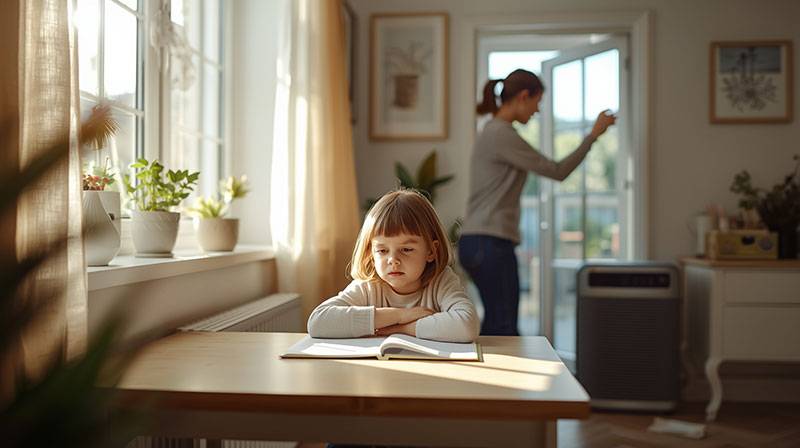How Indoor Air Quality Affects Your Child’s Health and Learning
Have you ever wondered why your child seems to catch more colds at certain times of the year? Or why they struggle to focus on homework in certain rooms of your house? The answer might be floating right in the air around them.
Indoor air quality is something most parents don’t think about until there’s an obvious problem. But the air inside your home has a big impact on your child’s health, sleep, concentration, and even their mood. Let’s explore why clean indoor air matters and what you can do to improve it.
What Is Indoor Air Quality?
Indoor air quality, often called IAQ, refers to how clean and healthy the air is inside buildings. It includes everything floating in the air you breathe at home: dust, pollen, pet dander, mold spores, bacteria, viruses, and even chemicals from cleaning products or furniture.
You might think outdoor air is dirtier than indoor air, but that’s not always true. According to the Environmental Protection Agency, indoor air can be two to five times more polluted than outdoor air. Sometimes it’s even worse than that!
Why? Because homes today are built to be energy-efficient, which means they’re sealed tightly to keep heating and cooling inside. This is great for your energy bill, but it also means fresh air doesn’t circulate as well. Pollutants get trapped inside with nowhere to go.
How Poor Air Quality Affects Children
Children are more vulnerable to air quality problems than adults for several important reasons:
They breathe faster. Kids take more breaths per minute than adults, which means they inhale more air and any pollutants in it relative to their body size.
Their bodies are still developing. Young lungs, brains, and immune systems are growing. Exposure to pollutants during these critical years can have lasting effects.
They spend more time indoors. Between school, homework, and indoor play, children often spend 80-90% of their time inside buildings.
They’re closer to the ground. Many pollutants like dust and pet dander settle on floors and carpets right where young children play.
Poor indoor air quality can cause or worsen several health issues in children:
Respiratory Problems
Breathing polluted air can trigger asthma attacks in children who have asthma, or even contribute to developing asthma in children who didn’t have it before. Symptoms include:
- Coughing and wheezing
- Shortness of breath
- Chest tightness
- Difficulty breathing during physical activity
Even children without asthma can develop respiratory irritation from poor air quality, leading to frequent coughs, stuffy noses, and throat irritation.
Allergies
Indoor allergens like dust mites, pet dander, and mold spores float through the air and settle on surfaces. When children breathe these allergens, their immune systems react, causing:
- Sneezing and runny nose
- Itchy, watery eyes
- Skin rashes
- Fatigue from poor sleep due to congestion
Sleep Problems
Children need quality sleep for growth, learning, and emotional regulation. Poor air quality disrupts sleep in several ways:
- Congestion makes breathing difficult
- Allergens cause discomfort and restlessness
- Poor temperature control affects sleep quality
- Dry air irritates throats and nasal passages
When children don’t sleep well, they struggle with concentration, memory, mood, and behavior the next day.
Reduced Cognitive Function
Recent research has shown a surprising connection between air quality and brain function. Studies have found that children in classrooms with better ventilation and air quality perform better on tests and show improved concentration.
Poor air quality can cause:
- Difficulty focusing on schoolwork
- Slower problem-solving
- Reduced memory performance
- Increased fatigue and drowsiness
Increased Illness
Viruses and bacteria can spread more easily in poorly ventilated spaces with stagnant air. This is why children in schools with poor ventilation tend to get sick more often.
Good air circulation helps dilute and remove airborne germs, reducing the spread of colds, flu, and other illnesses.
Common Indoor Air Pollutants
Understanding what’s in your air helps you address the problem. Here are the most common culprits:
Dust and dust mites: These microscopic creatures live in bedding, carpets, and upholstered furniture. Their waste products trigger allergies and asthma.
Pet dander: Tiny flakes of skin from cats, dogs, and other furry pets float through the air and stick to surfaces.
Mold and mildew: These grow in damp areas like bathrooms, basements, and around leaks. Mold spores in the air cause respiratory problems and allergic reactions.
Pollen: Outdoor pollen finds its way inside on clothes, shoes, and through open windows.
Volatile Organic Compounds (VOCs): These chemicals come from cleaning products, air fresheners, new furniture, paint, and building materials. They can cause headaches, dizziness, and respiratory irritation.
Tobacco smoke: Even if no one smokes inside your home, smoke can drift in from neighbors or cling to clothes.
Carbon monoxide: This dangerous, odorless gas can come from gas appliances, fireplaces, or attached garages. It’s poisonous and can be deadly.
Simple Ways to Improve Air Quality at Home
The good news is that improving your home’s air quality doesn’t have to be complicated or expensive. Here are practical steps every family can take:
Keep Your Home Clean
Regular cleaning removes dust, pet dander, and other particles before they circulate through the air.
Helpful cleaning tips:
- Vacuum carpets and rugs at least twice a week with a vacuum that has a HEPA filter
- Dust surfaces with damp cloths rather than dry dusting, which just moves dust around
- Wash bedding in hot water weekly to kill dust mites
- Use doormats and remove shoes at the door to reduce tracked-in dirt
- Keep clutter minimal since it collects dust
Control Humidity
The ideal humidity level for homes is between 30-50%. Too much humidity encourages mold growth. Too little dries out respiratory passages and makes children more susceptible to illness.
Managing humidity:
- Use exhaust fans in bathrooms and kitchens when showering or cooking
- Fix any water leaks promptly
- Use a dehumidifier in damp basements
- Use a humidifier in dry climates or during winter
- Ensure clothes dryers vent outside
Improve Ventilation
Fresh air dilutes indoor pollutants and brings in oxygen-rich outdoor air.
Ventilation strategies:
- Open windows when weather permits, especially when cleaning or cooking
- Use kitchen and bathroom exhaust fans
- Don’t block air vents with furniture
- Ensure your home’s ventilation system is working properly
- Consider opening windows on opposite sides of the house to create cross-ventilation
Maintain Your HVAC System
Your home’s heating, ventilation, and air conditioning (HVAC) system plays a huge role in air quality. It circulates air throughout your home, filtering it in the process.
Essential HVAC maintenance:
- Change air filters regularly (every 1-3 months depending on the filter type)
- Schedule professional maintenance at least once a year
- Clean air vents and registers
- Consider upgrading to high-efficiency filters that capture smaller particles
- Ensure ductwork is sealed and clean
Professional HVAC services can assess your system’s air filtration capabilities and recommend improvements. Many modern systems include advanced air purification features that remove even microscopic pollutants, viruses, and bacteria.
Choose Low-VOC Products
Reduce chemical pollutants by making smart purchasing decisions:
- Select paints, cleaners, and building materials labeled “low-VOC” or “no-VOC”
- Use natural cleaning products like vinegar, baking soda, and lemon
- Avoid artificial air fresheners; open windows instead
- Let new furniture off-gas in a garage or outdoors before bringing it inside
- Store chemicals, paints, and solvents in sealed containers away from living spaces
Control Allergens
If your child has allergies or asthma, extra allergen control makes a big difference:
- Use allergen-proof covers on pillows and mattresses
- Keep pets out of bedrooms
- Remove carpets and choose hard flooring if possible
- Wash stuffed animals regularly
- Keep windows closed during high pollen days
- Bathe pets regularly to reduce dander
Add Indoor Plants (With Caution)
Some indoor plants can help filter air naturally. However, overwatering plants creates mold problems, so use them carefully:
- Spider plants
- Snake plants
- Peace lilies
- Bamboo palms
Keep plants healthy and avoid overwatering to prevent mold in the soil.
Creating a Healthy Sleep Environment
Since children spend about half their time in their bedrooms, making this space as healthy as possible is especially important.
Bedroom air quality tips:
- Keep the room well-ventilated
- Wash bedding weekly in hot water
- Use hypoallergenic pillow and mattress covers
- Keep the room dust-free
- Maintain a comfortable temperature (around 65-70°F is ideal for sleep)
- Use a HEPA air purifier if your child has allergies or asthma
- Keep humidity levels comfortable
- Remove unnecessary soft toys and clutter that collect dust
When to Seek Professional Help
Sometimes improving air quality requires professional expertise. Consider getting help if:
- Family members have frequent respiratory problems or allergies
- You notice mold growth
- There are persistent musty or chemical odors
- Your home feels stuffy despite opening windows
- Humidity levels are consistently too high or low
- Your HVAC system is old or not working efficiently
Professional services can include:
- Air quality testing to identify specific problems
- HVAC system inspection and cleaning
- Duct cleaning to remove accumulated dust and debris
- Mold inspection and remediation
- Installation of whole-home air purification systems
- Humidity control solutions
For families looking to optimize their home comfort systems, professional HVAC services can evaluate your current setup and recommend improvements tailored to your family’s needs and your home’s specific challenges.
Teaching Kids About Air Quality
Help children understand why air quality matters by involving them in solutions:
Make it educational:
- Explain how breathing works and why clean air is important
- Show them dust under a microscope or with a magnifying glass
- Do a “dust test” by placing dark paper on surfaces and checking it after a few days
- Let them help change air filters so they can see what’s being caught
Give them age-appropriate responsibilities:
- Younger children can help dust low surfaces with damp cloths
- Older kids can be responsible for changing their own bedding
- Teenagers can learn to change air filters and monitor humidity levels
- Everyone can practice removing shoes at the door
Connect it to how they feel:
- Discuss how they breathe easier and sleep better when the air is clean
- Notice improved focus during homework time
- Recognize when allergies flare up and identify possible triggers
The Bottom Line
The air your children breathe at home affects their health, sleep, learning, and overall well-being more than most parents realize. The good news is that improving indoor air quality doesn’t require major renovations or expensive equipment.
Start with simple steps: clean regularly, control humidity, improve ventilation, and maintain your HVAC system. These basics make a significant difference for most families.
Pay attention to your children’s health. If they have frequent respiratory issues, poor sleep, or difficulty concentrating, poor air quality might be contributing. Take steps to address it, and you’ll likely see improvements in their health and happiness.
Remember, creating a healthy home environment is one of the best investments you can make in your children’s present and future well-being. Clean air isn’t a luxury. It’s a necessity for growing, learning, and thriving.
About the Author: This article was written to help parents and educators understand the importance of indoor air quality for children’s health and development. For more information about maintaining healthy home environments, consult with healthcare providers and home comfort professionals.


